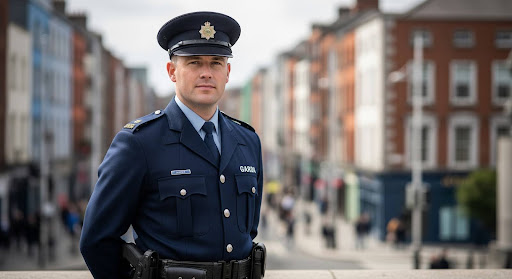When the first members of An Garda Síochána took to the streets in 1922 following the establishment of the Irish Free State, they represented not just a new police force, but a visual break from the Royal Irish Constabulary that had preceded them. Over the century that followed, the iconic Garda uniform would undergo numerous transformations, each reflecting changing times, technologies, and the evolving role of policing in Irish society.
1920s: The Birth of a National Identity
The initial Garda uniform was deliberately distinct from its predecessor. The dark green RIC uniforms gave way to a navy blue tunic with silver buttons bearing the Irish harp. The high-necked collar featured silver numerals indicating the Garda’s identification number. The cap was particularly distinctive – a soft, peaked cap adorned with a silver harp badge. This uniform represented more than mere clothing; it symbolised the new Irish state asserting its independence and sovereignty.
Equipment was basic by today’s standards – a truncheon, whistle, notebook, and in some cases, a revolver. Gardaí primarily patrolled on foot or bicycle, maintaining close contact with the communities they served.
1930s-1940s: Wartime Adaptations
During the Emergency (World War II), the Gardaí faced new challenges and responsibilities. Material shortages meant uniforms were often mended rather than replaced. The distinctive cape, which had been part of the uniform since the beginning, proved practical in Ireland’s rainy climate and continued as a signature element of the Garda appearance.
Communication equipment remained limited, with stations connected by telephone, but individual Gardaí still relied primarily on whistles to summon assistance.
1950s-1960s: Modernisation Begins
The post-war period saw gradual modernisation. The uniform retained its basic appearance, but materials improved, and the cut became more contemporary. The traditional high collar gave way to an open-necked tunic with a shirt and tie. The cape began to be phased out for regular duty, though it remained for ceremonial occasions.
The most significant changes came in equipment. Radio communications began to be introduced, initially in vehicles and later as personal equipment. The Garda fleet expanded beyond bicycles to include more motor vehicles, changing how officers patrolled and responded to incidents.
1970s-1980s: The Troubles and Tactical Changes
The period of the Troubles brought significant changes to Garda equipment, particularly for those serving in border regions. Personal protection equipment became more common, and specialised units received tactical gear, including bulletproof vests – a stark departure from the traditional uniform.
The standard uniform evolved, too, with more practical materials and designs. The formal tunic began to be replaced by a more versatile jacket for everyday duties. Women officers, who had joined the force in increasing numbers since the 1950s, saw their uniforms gradually become more practical and less gender-distinct.
1990s-2000s: The Technology Revolution
The late 20th century brought perhaps the most dramatic changes in Garda equipment, if not appearance. Computer systems, improved communications, and modern forensic techniques transformed policing capabilities. The uniform evolved more subtly, with high-visibility elements added for safety and a gradually more relaxed approach to formal elements.
Body armour became standard issue rather than specialised equipment, reflecting both safety concerns and international policing trends. The traditional whistle, once a Garda’s primary means of communication, became largely ceremonial as personal radios became ubiquitous.
2010s to Present: The Modern Force
Today’s Garda uniform bears both similarities and stark differences to its 1922 predecessor. While the navy blue colour remains, modern fabrics offer greater comfort and practicality. The current operational uniform consists of a blue shirt (short or long-sleeved, depending on weather), navy cargo trousers, and a softshell jacket bearing the Garda crest and high-visibility markings.
Equipment has evolved beyond recognition – body cameras, smartphones, specialised vehicles, and less-lethal options like tasers complement traditional policing tools. Public order units and emergency response teams have equipment that would have been unimaginable to the first Gardaí.
The iconic peaked cap remains, though modernised, providing a visual link to the force’s heritage while serving a practical purpose. Female officers now have uniforms designed with their needs in mind rather than modified versions of men’s uniforms.
Ceremonial Traditions
Despite these changes, ceremonial occasions still see Gardaí in formal uniforms that would be recognisable to their predecessors – a testament to the value placed on tradition and continuity. The dress uniform with white gloves, pristine tunics, and formal caps provides a visual link to the force’s century of service.
Conclusion: More Than Just Clothes
The evolution of the Garda uniform and equipment tells a story beyond mere fashion or technology. It reflects Ireland’s journey as a nation, changing social attitudes, advances in materials and design, and the evolving nature of policing itself.
From the distinctive appearance that helped establish a new national identity in 1922 to today’s blend of tradition and cutting-edge technology, the blue uniform has remained a powerful symbol of An Garda Síochána’s role in Irish society, adapting to changing times while maintaining its core identity and values.
As we look to the future, one can only imagine how the iconic blue uniform will continue to evolve while honouring its rich heritage.
Written by Sean Daly

